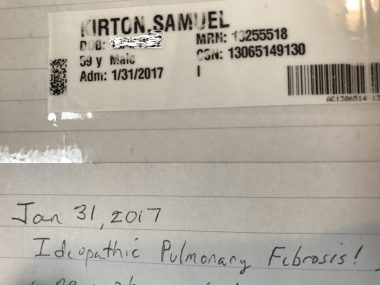A Journal’s Take on My Idiopathic Pulmonary Fibrosis Diagnosis
Sam Kirton describes the days following his diagnosis, and how he told others

“You have idiopathic pulmonary fibrosis.” January marks six years since those five words changed my life.
Late in 2022, I began a long overdue project renovating my home office, which had been delayed by procrastination. While doing so, I came across a journal I had started writing around the day of my diagnosis.
I had long carried a journal of sorts to document meetings and decisions in my professional life, so I purposely started a new one to reflect upon the new chapter of my life.
In the beginning
Opening my journal recently was akin to visiting a personal time capsule. I sat down with it, which further delayed the renovation project. Sorry (not sorry)!
Taped to the top of the page was a hospital wristband issued to me when I checked in. There, in my handwriting, was all the emotion of my diagnosis, captured in words. Those words were committed to paper. It was the first time I had memorialized the three words “idiopathic pulmonary fibrosis.”

Sam’s journal entry on the day he was diagnosed with IPF. (Photo by Sam Kirton)
While reliving the early days of my diagnosis, it was just as fresh in my mind as the day it had occurred. My wife, Susan, had taken time off work to go with me to this appointment. Sitting next to me, she maintained her composure on a day that was very emotional for her, too.
And then …
Both Susan and I were established in our careers. But everything we knew about being successful seemed to be of little use at that moment. We had to sit down and determine the next steps. What needed to be done, and how would we prioritize the first step?
Initially, we didn’t share my diagnosis on social media, because we had to tell people in person first. So I called my mother and stepfather. As you might imagine, they were very supportive, and my mother had a hundred questions about what my future held. My two younger brothers were next on the list. Susan called her two sisters and mother. With each call, we asked them not to share the information on social media until they had seen me publicly share it.
Telling the kids
Although my kids, Christopher and Heather, are adults, telling them was going to be hard in my mind. They both lived outside of Detroit, Michigan, about 600 miles away from me. I reached out to their mother to arrange a time to call them when she could also be a part of the call. My diagnosis had been on a Tuesday, and I spoke with them the following weekend.
They had questions but were concerned about how I was feeling. Honestly, I felt fine at that point. We addressed their concerns to make them as knowledgeable as we were at that point on our journey.
Announcing it to others in our lives
Five days after I was diagnosed, we shared my diagnosis in an email with others in our lives. It was titled “Sit Down Before You Open This, Please.” The email shared what we knew at the time, a thumbnail of information compared to what we have learned over the past six years. I shared that, “I heard a jumble of words and numbers which when pulled together was bad.”
The response from those who received the email was positive and overwhelmingly supportive. It was the beginning of forming our village that would eventually become our support system for this journey.
The end of Day 1
I began this column with my recollection of my diagnosis and introduced you to the journal I started that day. Telling our family and friends was an essential part of what I wrote in that first entry.
I often see newly diagnosed patients seeking advice about when to tell family, friends, and associates about an idiopathic pulmonary fibrosis or other rare disease diagnosis. This is what I did with Susan’s help. Each of us must decide which communication strategy works best for the situation.
Looking back at my journal and reading the words in my own handwriting still takes my breath away (lung humor). I did notice several relevant themes as I read through the entries, which will be topics for future columns.
Writing these columns each week is a form of therapy for me. It’s how I can make every breath count.
Note: Pulmonary Fibrosis News is strictly a news and information website about the disease. It does not provide medical advice, diagnosis, or treatment. This content is not intended to be a substitute for professional medical advice, diagnosis, or treatment. Always seek the advice of your physician or other qualified health provider with any questions you may have regarding a medical condition. Never disregard professional medical advice or delay in seeking it because of something you have read on this website. The opinions expressed in this column are not those of Pulmonary Fibrosis News or its parent company, Bionews, and are intended to spark discussion about issues pertaining to pulmonary fibrosis.









Charles Berry
How old were you when diagnosed?
Samuel Kirton
Hi Charles,
Thanks for reading my column and for your question. I was 59 years old when I was diagnosed with idiopathic pulmonary fibrosis.
Sam ...
John Gould
Sam -
because you had a transplant - write the word GONE !!! after your words Idiopathic Pulmonary Fibrosis and date it with your new cured (transplant) date in your journal.
As a Christian, for decades I've kept a daily prayer journal and write thoughts that come to.mind in my daily devotions with God, dated prayer requests for others and for myself - when God answers them, I put a line through them and put a date on that line. They are a reminder of God's loving kindness to me and His faithfulness in my life
Samuel Kirton
Hi John,
There is much debate about that issue. Because the PF was idiopathic the cause is not known so you can never be clear whether it will return. I had one pulmonologist tell me that is it were too return I would likely outrun it the second time. It is why the PF community must continue to support further research to identify the cause of IPF.
Sam...